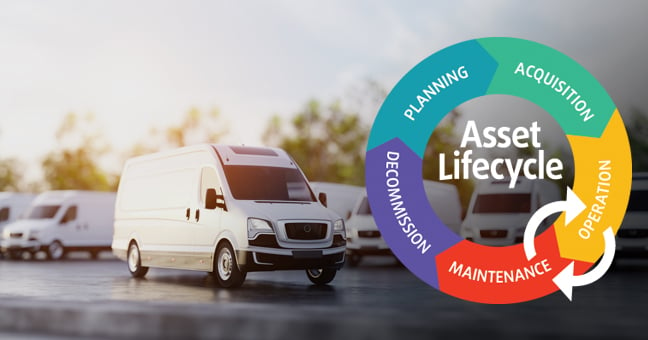

May 27 2025
It turns out that consumers are not the only ones holding onto their vehicles longer. 30 percent of fleet managers also plan to extend the lifecycle of their vehicles, according to an EVAI survey referenced in this Digital Dealer article. The survey attributes this to the potential cost increases from import tariffs, however, vehicle prices and interest rates have been climbing for a while (pre-tariffs), dating back to the COVID pandemic where the supply chain became a major issue for acquisition. According to this Automotive Fleet article, fleet managers have been extending the use of their fleet vehicles for a few years now.
In a time where budgets are tight, rather than stretching fleet budgets thin by replacing vehicles at a certain fixed mileage or age milestone (regardless of vehicle condition), fleet managers can better maximize the value of each asset by implementing a “fleet preservation” strategy coupled with advanced fleet management tools and telematics data.
What is the best way for fleet managers to maximize the value of each asset without sacrificing vehicle performance or risking costly downtimes? Ongoing preventative maintenance is crucial, which requires sticking with recommended service schedules and utilizing the vehicles’ telematics data to address potential problems or minor repairs before they become bigger, more expensive repairs. Poorly maintained fleets can result in longer downtimes, unexpected breakdowns, and even increased safety concerns for the drivers.
Additionally, certain fleet preservation strategies can help “mitigate the negative impact of operating higher-mileage vehicles.” For example, while wear and tear is expected, with better driving habits, more efficient route planning, and less idling time, some of these regular maintenance and repair items can be prolonged. Fleet managers will need to analyze the data to determine when each asset truly needs to be replaced from an operational costs vs. fixed costs standpoint.
Vehicle acquisition and remarketing of older fleet vehicles is quite complex in today’s climate. According to Jason Kraus, VP of operations at Mike Albert Fleet Solutions, “Supply chains are healing, but interest rates aren’t dropping as fast as fleets hoped. That means every acquisition, financing deal, and remarketing decision has to be carefully measured.” Not only are new vehicles more expensive with interest rates still increased and tariffs coming into play, but holding onto fleet vehicles for longer lifecycles could also decrease their resale/trade-in value. Fortunately for fleet managers, “the average used vehicle hitting the secondary market will be older, have higher mileage, and likely have considerably more wear than the pre-pandemic inventory,” according to Holly Vollant, Remarketing Manager at Holman. So, depreciation within the used vehicle market is a pretty level playing field.
While fleets may be holding on to their vehicles for longer lifecycles, they should still be looking to acquire new vehicles to ensure a mix of vehicle ages and minimal downtime waiting on replacement orders. These vehicles should be ordered early when model-year order banks open. Additionally, simplifying vehicle specifications and being flexible with trim, options, color selection, etc. can help minimize delays in the order-to-delivery process. Learn more about acquisition strategies here.
Not all vehicles depreciate at the same rate, and it’s important to make sure your fleet isn’t aging simultaneously to minimize downtime. There’s no exact time to remarket each aging asset. Ultimately, fleet managers need to analyze the downtimes and expenses of maintaining/repairing each vehicle to determine when it’s time to remarket. “Remember the last day of a high mileage vehicle's life, the day it has a catastrophic failure, can easily cost $10,000 after you consider the loss of remarketing value, downtime, and a more expensive stock buy with more equipment than needed,” stated Jeff Krogen, vice president of Fleet Strategy at Enterprise Fleet Management.
Extending the lifecycles of fleet assets can impact many parts of the industry. While dealers might expect to see fewer vehicle sales from fleets due to longer lifecycles, the Digital Dealer article referenced above discusses increased service opportunities for dealers. “Dealers can provide solutions such as preferred service pricing, priority repairs, and predictive maintenance.” OEMs and 3rd parties can also expect more opportunities in increased part sales and maintenance/repair services.
Extending the life of fleet assets could also have some negative impacts on the auto industry. For example, slower fleet electrification will hamper efforts to reduce emissions. EV adoption has already hit several speed bumps in the fleet industry. According to a Ridecell article, “Making the shift from gas and diesel to electric is a massive undertaking. The initial cost and logistic challenges of transitioning fleets can often result in slow adoption.” Another major impact of extended fleet lifecycles is a further reduction in the amount of pre-owned vehicles available.
Something as simple as extending the life of fleet assets could impact the automotive industry in several ways, both positively and negatively, depending on where you are positioned within the industry. It will be interesting to see if this pattern continues long term. This will largely depend on all of the variables that got us here in the first place, such as increased vehicle prices, interest rates, supply chain issues, and import tariffs. We’d love to hear what you think about this topic in the comments section below!